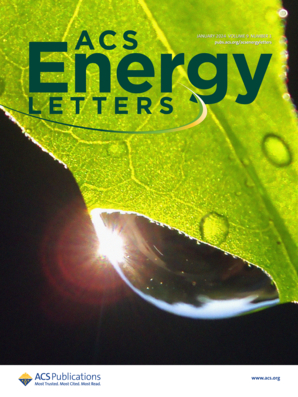Fabrication of Conductive Perovskite-Additive Networks Via Sequential Vacuum Deposition for Perovskite Light-Emitting Diodes
IF 19.3
1区 材料科学
Q1 CHEMISTRY, PHYSICAL
引用次数: 0
Abstract
Thermally evaporated perovskite light-emitting diodes (PeLEDs) have emerged as promising candidates for next-generation displays owing to the high reproducibility and scalability of thermal evaporation. However, the performance of thermally evaporated PeLEDs remains inferior to that of solution-processed PeLEDs. In this study, conductive perovskite-additive networks are fabricated through multisource sequential vacuum deposition using CsBr, PbBr2, and bis[2-[(oxo)diphenylphosphino] phenyl] ether (DPEPO). The phosphine oxide group in DPEPO retards crystal growth during crystallization, thereby reducing the grain size, increasing the exciton binding energy and decreasing the defect density. The enhanced electron mobility of the target perovskite device is attributable to the reduced trap density and π–π* stacking and upward shift of the Fermi level, which result in improved charge transport. The target perovskite device exhibits a remarkable external quantum efficiency of 16.91% and an operational half-lifetime of 191 h at 100 cd m–2, representing the highest reported values for thermally evaporated PeLEDs.

连续真空沉积制备钙钛矿发光二极管导电钙钛矿-添加剂网络
由于热蒸发的高再现性和可扩展性,热蒸发钙钛矿发光二极管(PeLEDs)已成为下一代显示器的有希望的候选者。然而,热蒸发ped的性能仍然不如溶液处理ped。在本研究中,利用CsBr、PbBr2和双[2-[(氧)二苯基膦]苯基]醚(DPEPO)通过多源连续真空沉积制备了导电钙钛矿添加剂网络。DPEPO中的氧化膦基团在结晶过程中阻碍了晶体的生长,从而减小了晶粒尺寸,增加了激子结合能,降低了缺陷密度。靶钙钛矿器件电子迁移率的提高是由于陷阱密度和π -π *堆积的降低以及费米能级的向上移动,从而改善了电荷输运。目标钙钛矿器件表现出16.91%的外量子效率和100 cd - m-2下191 h的工作半衰期,代表了热蒸发pleds的最高报道值。
本文章由计算机程序翻译,如有差异,请以英文原文为准。
求助全文
约1分钟内获得全文
求助全文
来源期刊

ACS Energy Letters
Energy-Renewable Energy, Sustainability and the Environment
CiteScore
31.20
自引率
5.00%
发文量
469
审稿时长
1 months
期刊介绍:
ACS Energy Letters is a monthly journal that publishes papers reporting new scientific advances in energy research. The journal focuses on topics that are of interest to scientists working in the fundamental and applied sciences. Rapid publication is a central criterion for acceptance, and the journal is known for its quick publication times, with an average of 4-6 weeks from submission to web publication in As Soon As Publishable format.
ACS Energy Letters is ranked as the number one journal in the Web of Science Electrochemistry category. It also ranks within the top 10 journals for Physical Chemistry, Energy & Fuels, and Nanoscience & Nanotechnology.
The journal offers several types of articles, including Letters, Energy Express, Perspectives, Reviews, Editorials, Viewpoints and Energy Focus. Additionally, authors have the option to submit videos that summarize or support the information presented in a Perspective or Review article, which can be highlighted on the journal's website. ACS Energy Letters is abstracted and indexed in Chemical Abstracts Service/SciFinder, EBSCO-summon, PubMed, Web of Science, Scopus and Portico.
 求助内容:
求助内容: 应助结果提醒方式:
应助结果提醒方式:


